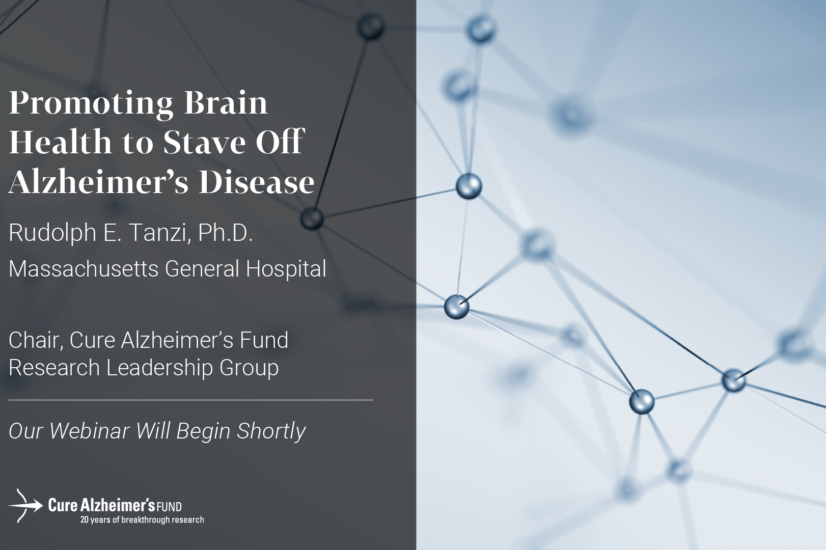Cure Alzheimer’s Fund presented a webinar, Two Sides of Abeta for the Layperson, on Wednesday, Jan. 25, 2012. The presentation, moderated by David Shenk, author of the national bestseller The Forgetting, Alzheimer’s: Portrait of an Epidemic, featured Dr. Rudy Tanzi and Dr. Rob Moir.
These Alzheimer’s experts looked at Abeta and its implications in the work toward a cure for Alzheimer’s disease. For the last 27 years, Abeta, a fatty protein that is created in the brain, has been identified as “residual junk” and the leading cause of Alzheimer’s disease. As a result, the majority of research efforts into the cause of Alzheimer’s have targeted Abeta as the enemy. But recent studies financed by Cure Alzheimer’s Fund have indicated that simply wiping out Abeta in the brain is not the solution.
Dr. Rudy Tanzi is the Joseph P. and Rose F. Kennedy Professor of Neurology at the Harvard Medical School and the director of the Genetics and Aging Research Unit at Massachusetts General Hospital. He has been investigating neurodegenerative disease since 1980, when he participated in the pioneering study that led to the location of the Huntington disease gene. He has identified several Alzheimer’s disease genes, including the first Alzheimer’s gene, the beta-amyloid protein precursor (APP). His work in the Alzheimer’s Genome Project™, which has identified other new Alzheimer’s genes, was recognized by TIME magazine as one of the top 10 medical breakthroughs of 2008. Dr. Tanzi is a world-renowned leader in the studies of Alzheimer’s disease genetics.
Dr. Robert Moir, assistant professor in Neurology, MGH Neurology Research and Harvard Medical School, obtained his Ph.D. from the University of Melbourne in the laboratory of Professor Colin Masters, one of the pioneers and founders of the modern era of Alzheimer’s disease research. He joined the research unit of Professor Rudolph Tanzi at Harvard Medical School and Massachusetts General Hospital in 1994 as a postdoctoral fellow. He is now an assistant professor with joint appointments at HMS and MGH and runs his own research laboratory located at the MIND research facility in Charlestown, Mass.
David Shenk is the award-winning and national bestselling author of six books, including The Genius in All of Us (“deeply interesting and important”–The New York Times), The Forgetting (“remarkable”–Los Angeles Times), Data Smog (“indispensable”–The New York Times), and The Immortal Game (“superb”–The Wall Street Journal). He is a popular lecturer, a short-film director and a correspondent for TheAtlantic.com. He has contributed to National Geographic , Slate , The New Yor k Times , The Wall Street Journal , Gourmet, Harper’s , Spy, The New Y orker, NPR and PBS. Shenk lives in Brooklyn.
Answers to Questions
General Alzheimer’s/Research questions
Q: What is the most effective (most predictive) animal model for AD that is used prior to initiating human studies?
The most commonly used laboratory animal for Alzheimer’s research is the mouse. Mice mature quickly, have relatively short life spans and are easy to work with in the laboratory–all key criteria for learning about the role of specific genes in Alzheimer’s pathology as well as the effectiveness of therapeutic interventions. However, as all researchers know, it’s a long road from success in the mouse to success in the human.
There are several genetic “models” of mouse currently used in Alzheimer’s research labs, and new models are being developed all the time. As of January 2012, the most commonly used mouse model is called tg2576, in which an early-onset familial AD gene mutation in the amyloid precursor protein (APPswe) has been inserted in the mouse’s DNA. There are also a number of variations on this model. By using more than one model, it is possible for researchers to compensate for each model’s limitations.
Q: Is it true that a loss of smell may be an early indicator of AD?
It appears so, and new research corroborates this longtime anecdotal observation. We’ve known for a while that Abeta accumulates first in parts of the brain associated with smell (the olfactory bulb), well before accumulating in areas associated with cognition and coordination. Recent mouse experiments at Case Western Reserve have demonstrated that as amyloid beta increases in the olfactory bulb, the bulb becomes less active. Despite spending more time sniffing, the mice failed to remember smells and became incapable of telling the difference between odors. Meanwhile, the rest of the mouse brain continued to act normally at this very early disease stage.
This is intriguing, but not confirmatory research. Much more work needs to be done.
Q: I’m 55. Can I be tested using biomarkers now? My paternal grandmother had Alzheimer’s and my father has Alzheimer’s.
There are several clinical trials under way to try to determine reliable biomarkers, but none right now are commonly accepted in clinical practice. In the not-too-distant future, spinal taps may offer the best clues to the early initiation of AD, and may be used in concert with brain imaging to detect beta-amyloid deposition in the brain.
Q: How optimistic are Dr. Tanzi and Cure Alz that government will step up?
More federal funding is critical, and we are not there yet. The National Alzheimer’s Project Act, signed into law in January 2011, represents a major step forward in Alzheimer’s awareness and action. It is designed to help the government develop a new “national strategy” for Alzheimer’s.
However, only with immense public pressure–remember AIDS and polio!–will the U.S. government allocate significant more funding for Alzheimer’s specifically. You can help by writing your congressperson and senators. That IS effective!
Please note that after the webinar, the administration announced a proposed increase of $156 million for government sponsored research on Alzheimer’s disease through the National Institutes of Health (NIH). Priority projects for this funding, according to Dr. Francis Collins, director of NIH include genetic studies, are stem cell research for Alzheimer’s and more work on the APOE4 gene, which increases risk for “sporadic” (regular) onset Alzheimer’s. All of these areas have been topics of concentration for Cure Alzheimer’s Fund research, and we applaud the administration for taking this action in this time of economic austerity. No one believes this is anywhere near enough money, but it is very positive movement in the right direction, brought about by the concerted action of Cure Alzheimer’s Fund and other Alzheimer’s organizations and individuals appealing to the administration and members of Congress for more help in combating this disease.
Q: I have Alzheimer’s in my family (my mother has it) and I have a history of Traumatic Brain Injury. What should I look for or have tested?
It would be a good idea to see a neurologist about your history, so that together you can choose the right course.
Q: What research is being done for delaying onset?
A good deal of current research is dedicated to delaying onset by detecting who is at most risk for the disease before they are symptomatic and developing therapies to intervene in the pathology before it takes hold. This approach is dependent upon:
(1) Better understanding of the genetics that drive the disease (who is genetically at most risk);
(2) Better understanding of the “environmental” factors such as stroke, brain injury or other assaults to the brain that can either initiate or accelerate the pathology; and
(3) Good “biomarkers” or physical evidence of the presence of the pathology, either in nascent or active form, so the progress of treatment can be measured. Most therapies that are being developed for treatment of AD also can be used earlier for prevention.
Q: Does a pre-existing neurological disease such as MS increase the risk of Alzheimer’s?
Q: Is AD more prevalent in people who already have another underlying disease such as RA? If so, what comes first, “the chicken or the egg”?
There are no data we are aware of to suggest that MS or RA are risk factors for AD. Stroke is a risk factor for AD. A link between diabetes and AD has been noted for several decades, and is currently the subject of close examination in research funded by Cure Alzheimer’s Fund and the National Institutes of Health.
Q: Have there been any studies on MCT or coconut oil arresting or reversing AD as per those videos circulating on the Internet?
Coconut oil, like simple sugar in a dessert, can provide extra fuel to the brain, and this can result in a temporary period of greater awareness. However, it does nothing to treat or stop the disease.
There are a number of claims for particular foods protecting against AD. However, to date, none have stood up under close clinical examination.
Q: I’ve been hearing that Vitamin D is crucial for a healthy immune system. Is there any connection to lack of D and the risk of Alz.?
There are a handful of studies suggesting that low vitamin D levels can increase risk for AD, but it is not yet confirmed. Notably, vitamin D deficiency is relatively rare in the tropics–it is sometimes called the “sunshine” vitamin–and AD rates in that region have not been reported as reduced.
In any event, it is a good idea to have your vitamin D levels checked by your physician and supplement as necessary.
Q: If you were APOE 4/4, with both parents and a brother with known Alzheimer’s, age 70, and asymptomatic, would you start using nasal insulin?
It is not yet confirmed whether nasal insulin can treat the disease. Like coconut oil or sugar, it can provide extra fuel to the brain and this can result in a temporary period of greater cognition. However, there are no current data to indicate it treats or stops the disease.
Q: Is the science coming together? OR based on Rob’s talk with the new idea of Abeta, are there more targets, which is causing the research to spread out and actually make it longer toward finding a cure?
There is an emerging consensus. The combined science is now suggesting that beta-amyloid is normally made in the brain, perhaps to fight infections, as Rob’s data suggest. If too much beta-amyloid accumulates in the brain, it will trigger the formation of tangles, made up of the protein tau. Once the tangles form, they can spread from nerve cell to nerve cell.
The aim is therefore to keep beta-amyloid down at safe levels in the brain before tangles are triggered, and to develop an anti-tangle therapy as well. Cure Alzheimer’s Fund is funding both strategies.
Q: Can a blood test detect the genes that have Alzheimer’s?
Yes, but only for mutations (APP, PSEN1, PSEN2) that cause a very rare (less than 2 percent) early-onset form of the disease.
In the other 98 percent of AD cases, there is no reliable genetic test–partly because, in these cases, the disease is not directly caused by specific genes. The most common scenario is for a large number of genes to interact with the body’s environment over time to produce the conditions that produce Alzheimer’s. Certain gene mutations (such as APOE4) do confer a much stronger risk of Alzheimer’s, and Cure Alzheimer’s Fund’s Alzheimer’s Genome Project™ is working on developing such a test.
For more on the genetics of Alzheimer’s, watch this very short film.
Q: If your parent had Alzheimer’s, how does that impact your odds of getting it?
Having parents with AD increases risk, but there are no hard numbers for how much. It depends on how early they started the disease. The earlier the onset, the stronger the genetic risk.
Q: Rudy, I heard you say to Deepak Chopra that mice that exercise don’t get Alzheimer’s, and mice that don’t exercise get Alzheimer’s. How might good exercise affect Abeta? If you have one suggestion for the Alzheimer’s community, what would it be?
It’s all about blood flow. The simple formula is “what is good for the heart is good for the head.” Sensible diet, control of stress and good daily exercise are currently the best recommendations we can make.
Abeta Questions
Q: How should the identification of Abeta as an antimicrobial peptide (AMP) affect the appropriate direction of future AD research?
We should–and will–pursue therapies that modulate Abeta’s production, aggregation and clearance but do not destroy it altogether. The pharmacological trick is to balance Abeta correctly to allow it to function normally without excessive build-up or retention.
In the long term, we’d also like to see research identifying specific “triggers” that may kick-start Abeta amyloidosis. Most likely, those triggers are real or perceived infections.
Q: Within the framework of the Abeta theory, could Dr. Tanzi hypothesize why exercise might be protective against AD?
Again, it’s all about blood flow. The simple formula is “what is good for the heart is good for the head.” Sensible diet, control of stress and good exercise are currently the best recommendations we can make. There is evidence from mice studies that exercise can trigger the breakdown of beta-amyloid in the brain by turning on certain genes.
Q: What novel approaches to attack AD are you currently studying that are based upon its recently discovered immune system activity?
We first have to confirm this process, for which there is strong evidence but not yet conclusive proof. If it does prove to be correct, the implications for modifying Abeta production, aggregation and clearance are profound, and will involve interventions that promote and maintain the appropriate balance–not the elimination–of Abeta.
Most of our current focus is on how the initiation of the brain’s immune system–by a bacterial pathogen, for example–also turns on the production of Abeta.
Q: Is beta amyloid related to other proteins, normal or abnormal? How is it made?
Abeta (beta amyloid) is a member of a class of abnormal protein substances called amyloids of which amylin, a diabetes-related protein, is also a member. Beta-amyloid is made of Abeta, and is produced when the enzymes called beta secretase and gamma secretase cut or snip a protein called APP ( Abeta Precursor Protein )to release a smaller protein or “peptide” then called Abeta. If Abeta accumulates in too great an amount, it can form clumps that attack nerve cells and synapses.
Q: Is imaging of amyloid plaque reliable?
Imaging of plaques in the brain is reliable now (with Pittsburgh Compound B, Avid) and comports well with autopsy results. However, the individual components of the plaque thought mostly to be composed of Abeta oligomers are not yet discernable by imaging. It is also important to note that contrary to earlier belief, a noticeable plaque load in the brain does not necessarily mean the person has Alzheimer’s disease. Autopsies have shown that some people with significant plaque load do not have the disease while some others with no discernable plaque do. Plaque load is a useful indication of Alzheimer’s pathology, but does not absolutely confirm the presence of the disease.
Q: Are there male/female differences in amyloid plaque?
In mouse models of the disease using human AD gene mutations, females get more plaques than males. It is still not clear why and remains an important area of study.
Q: Is there some way to determine/measure the optimum level of Abeta in the brain–if in fact there is an optimum level?
The issue is less an optimal level than it is an optimum balance in the ratio of the Abeta42 variant versus the Abeta40 variant. When there is more Abeta42 present than in the normal 42/40 ratio (9/1), Alzheimer’s disease is much more likely to occur. We do not yet know what levels Abeta42 or 40 are optimal.
Bap related
Q: Does bapineuzumab wipe out the amyloids or reduce the levels?
Bapineuzumab, a drug currently in trials, is designed to bind to and remove beta-amyloid that occurs in the brain by triggering brain cells known as microglia to breakdown the amyloid.
Q: If Bapi is ultimately approved, does that make it more difficult for your research, because people may think the problem is being solved by the pharmaceutical companies?
Bapi approaches one element of the pathology, which is to clear over-accumulated Abeta. That would be helpful if proven safe and effective for all genotypes. However, other drugs that interrupted the pathology before symptoms occurred, or disrupted the Abeta/Tau link, or attacked the aggregation of Abeta in the toxic oligomers, would add significantly to the arsenal of weapons to be used against the disease at different phases of its pathology.
Q: Do Bapineuzumab and microbleeds have implications for clearance as a target for Tx?
Patients who are APOE4-positive (60 percent of AD patients) are more prone to blood vessel inflammation (vasogenic edema) and micro-hemorrhage than non-carriers when being treated with Bapineuzumab. So, they must be carefully monitored by brain imaging in ongoing clinical trials using Bapineuzumab.







